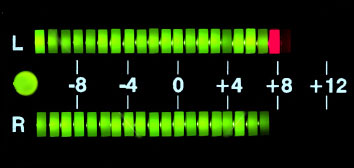- Home
- Products
- Sound Tech and PA
- Sound Tech DVDs & Downloads
- Free Tech Resources
- Free Sound Tech Lessons
- Playing By Ear
- Play By Ear DVDs & Downloads
- Ear Training & Music Theory Resources
- Worship Leading
- Worship Leading Course Downloads
- Free Worship Leader Training
- Free Worship Leader Resources
- Worship Band Skills
- Band Skills DVDs & Downloads
- DIY Worship Team Workshops
- Free Worship Team Training
- Free Worship Team Resources
- Set gain to minimum
- Push fader to -5dB (minus 5)
- Pad if necessary
- Shut eyes!
- Add gain until it is at an appropriate volume level
- Open eyes and check that there are no red lights on the meter
- EQ to taste
- Adjust gain if necessary (EQ can compromise gain setting)
- Bring fader down to minimum
- Set monitor level as appropriate
- Fader back to -5dB
- Everyone happy? Move to next channel
Ask the Expert – Why shouldn’t we set gain levels according to the LED lights?
We posted a question recently concerning micing and setting up good vocals and guitar amps. Tim Horton from SFL Group made the comment:
“Setting up a good vocal – you can’t go wrong with an SM58 here. Sing straight into it (it should be touching your top lip!); set the desk gain according to your listening level not what the LED meters say; pop the filter in and even wind out the low-EQ as well. That should get you started…”
Now that comment got a request from Tim Brown asking Tim Horton to explain more about the LED issue. Here is Tim’s response:
Yes, this is something that I am asked about a lot…
The idea is that all too often we are setting our gain levels by the LEDs on the board; we spin the gain in until the lights tell us it’s the correct level.
But how do we know this is the right volume in the system?
What about doing it this way:
N.B. This should be done 1 channel at a time, not whilst everyone else is playing.
Some further thoughts; if you are doing it like this and adjusting the gain according to the volume level you require then you are engineering sound, rather than watching LED meters. The meters are helpful as a reference, but shouldn’t be used as a crutch.
The assumption is made that your system is capable of the sound levels you require of it! Of course, if the system cannot give you the volume you need then you will be hitting the red lights.
In a similar way, we should not be asking small speakers to give us a huge bass sound. If you haven’t got a sub then don’t try to get that punchy kick drum / bass guitar sound; the speakers simply won’t be able to keep up.
Ok, so you don’t have to shut your eyes, but if you are prone to watching the meter for level setting then why not?
It will take practise to get this right, especially once you set monitor levels.
Speaking of monitor levels; your front of house sound should be 10dB louder than the monitors / stage noise. If it’s not then the muffled monitor sounds will overpower your detailed FOH mix.
Once you have set the monitor levels, you should never adjust the gain as it affects the entire channel and all associated feeds (auxes for monitors, recording, effects; matrices, etc).
By setting the fader to -5dB we are giving ourselves an extra 15dB of level in the FOH which should be plenty of headroom in the mix.
I hope this helps!
Tim Horton is Project Manager at SFL Group.
New Sound Tech and PA Training for Churches DVD
Do check out our new Sound Tech and PA Training DVDs. Presented by Tim and the team at SFL it’s everything the church sound engineer needs to know!


 Free Band Skills course with all Musicademy or Worship Backing Band DVD orders
Free Band Skills course with all Musicademy or Worship Backing Band DVD orders  Free gift with all Musicademy and Worship Backing Band DVD orders
Free gift with all Musicademy and Worship Backing Band DVD orders  Worship Training Day Ealing London 5 November 2022
Worship Training Day Ealing London 5 November 2022  How to get maximum exposure for your song writing
How to get maximum exposure for your song writing  Streaming online church services: the tech, the tips and the stories from around the world
Streaming online church services: the tech, the tips and the stories from around the world  What do you most struggle with as a worship musician?
What do you most struggle with as a worship musician?  Worship Leader Training: Beginning and Ending Songs Well
Worship Leader Training: Beginning and Ending Songs Well  Learn how to play by ear
Learn how to play by ear  4 tips for making good use of your mic
4 tips for making good use of your mic 

